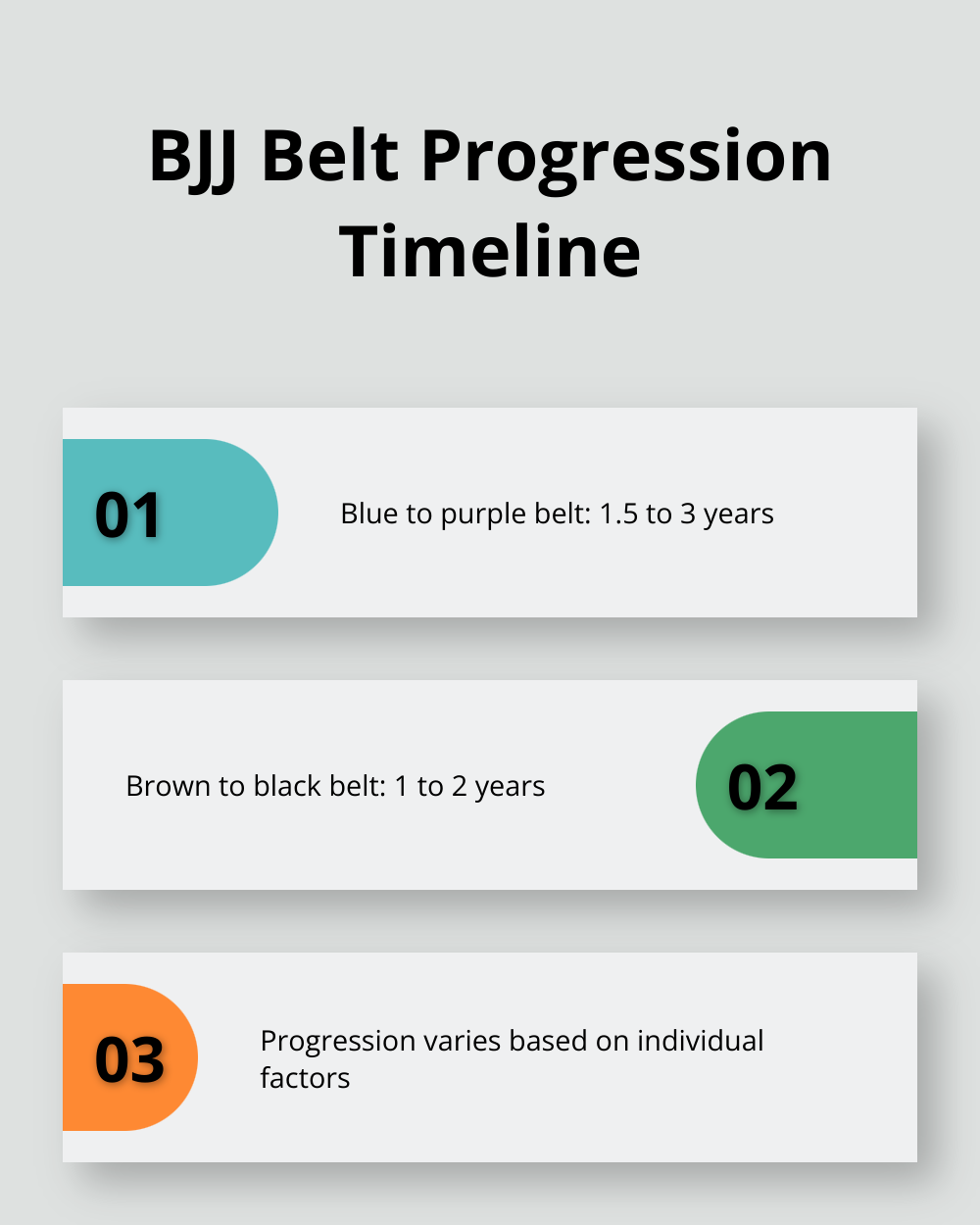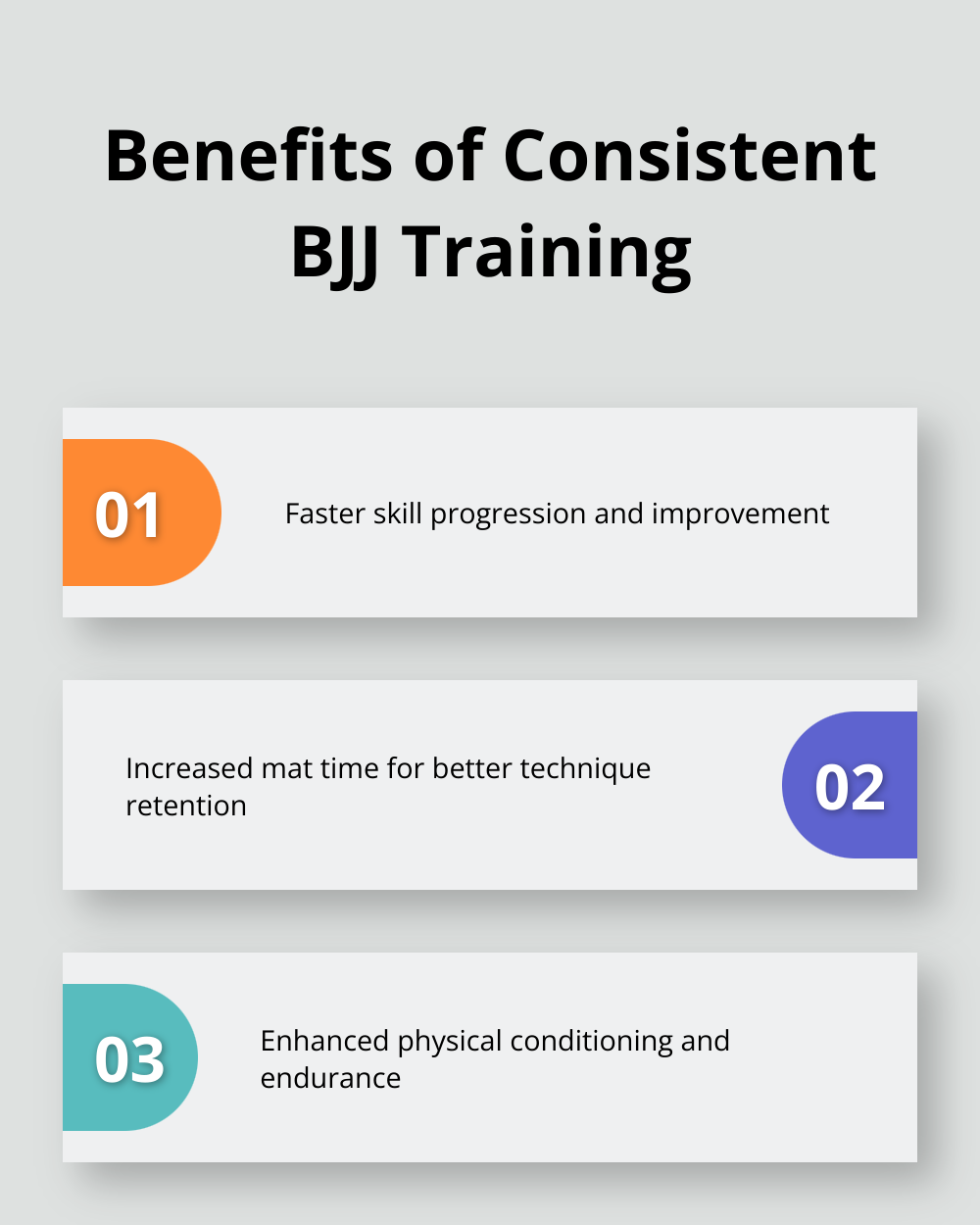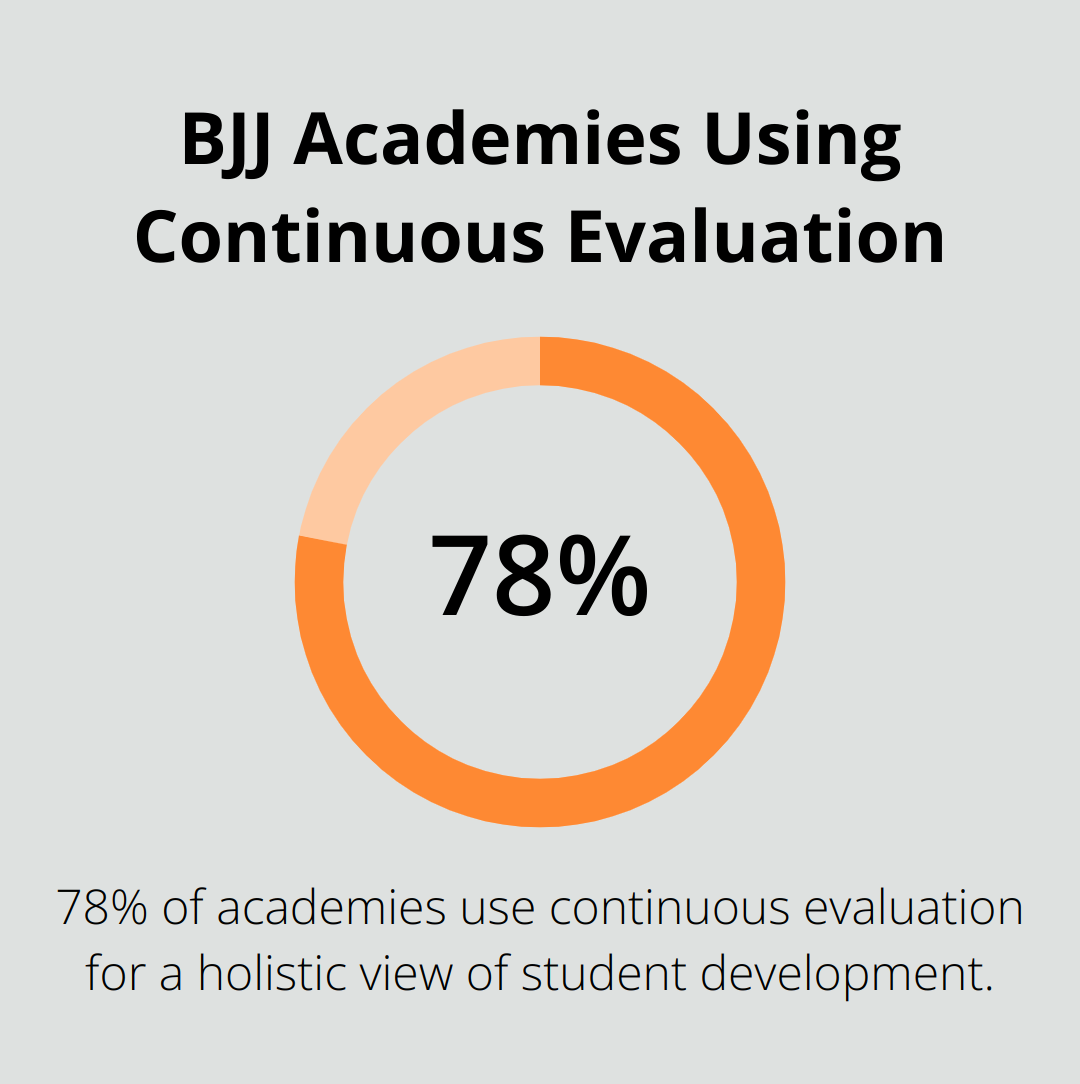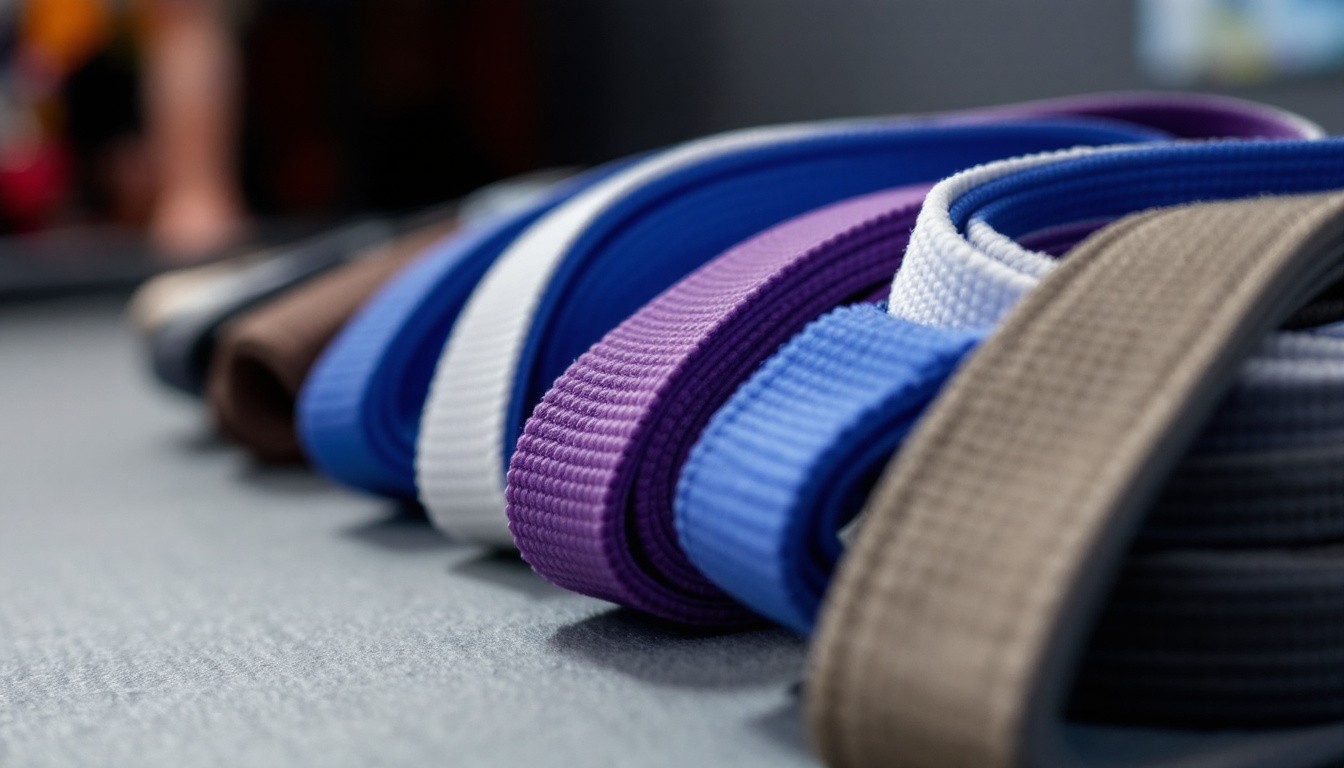At Jiu jitsu, we often get questions about the Jiu Jitsu belt system and how promotions work.
The journey from white to black belt is a fascinating aspect of Brazilian Jiu-Jitsu, filled with challenges, growth, and personal achievement.
In this post, we’ll break down the belt promotion process, exploring the criteria, methods, and traditions that shape a practitioner’s progression through the ranks.
What Are the BJJ Belt Colors and Their Significance?
Brazilian Jiu-Jitsu (BJJ) uses a belt system to mark a practitioner’s progress and skill level. At Souza Grappling Co., we follow the traditional adult belt progression: white, blue, purple, brown, and black. Each belt represents a significant milestone in a BJJ journey.
The Five Main Belt Colors
White belts are beginners who focus on foundational techniques and survival skills. Blue belts have a solid grasp of basic positions and submissions. Purple belts demonstrate advanced techniques and start to develop their own style. Brown belts show a high level of technical proficiency and often assist in teaching. Black belts are considered experts who embody mastery of BJJ techniques and principles.
Stripes and Their Meaning
Stripes on belts indicate progress within each rank. A practitioner can earn up to four stripes before becoming eligible for promotion to the next belt color. These stripes serve as motivation and recognition of consistent improvement. However, not all academies use the stripe system, and promotion criteria can vary.
Time Spent at Each Belt Level
The duration at each belt level varies widely among practitioners. Progression from blue to purple often takes 1.5 to 3 years. Brown belt is typically held for 1-2 years before black belt consideration.
It’s important to understand that these timeframes are not set in stone. Factors such as training frequency, natural aptitude, and competition performance can influence promotion speed. At Souza Grappling Co., we emphasize skill development and personal growth over rigid timelines.

The Role of Dedication and Consistency
Consistent training is key to progressing through the belt ranks. Regular attendance, active participation in sparring sessions, and a commitment to learning all contribute to faster skill acquisition. Our six-day availability at Souza Grappling Co. allows students to maintain a steady training schedule, supporting their journey through the belt system.
Factors Influencing Belt Progression
Several factors can affect how quickly a practitioner advances through the belt ranks:
- Training frequency (more mat time often leads to faster progress)
- Natural aptitude (some students may grasp concepts more quickly)
- Competition performance (success in tournaments can accelerate promotion)
- Instructor’s philosophy (some prioritize technical proficiency, others value mat time)
- Academy standards (requirements may vary between schools)
Understanding these factors can help practitioners set realistic expectations for their BJJ journey. As we move forward, let’s explore the specific criteria instructors use when considering a student for belt promotion.
What Criteria Determine Belt Promotions?
At Souza Grappling Co., we consider multiple aspects when evaluating students for promotion in Brazilian Jiu-Jitsu (BJJ). Our approach reflects a comprehensive assessment of a practitioner’s growth, encompassing technical skills, dedication, performance, and character.
Technical Proficiency and Skill Development
Promotion criteria for advancement to higher belts, such as purple belt, require significant technical skill, the ability to control and submit opponents, and a deeper strategic understanding. We look for a deep understanding of positional control, submissions, and defensive strategies. A blue belt seeking promotion to purple should demonstrate proficiency in advanced guard variations and the ability to chain submissions together smoothly.
Consistency and Dedication
Regular attendance and active participation in classes play a vital role in promotion decisions. Students who train at least three times a week typically progress faster than those with sporadic attendance. We track attendance and engagement to ensure students invest the necessary mat time. This consistency improves skills and demonstrates commitment to the art.
Competition Performance
While not mandatory, competition experience can accelerate your progress. Success in tournaments demonstrates your ability to apply techniques under pressure against resisting opponents. We also value how you handle losses and use them as learning experiences.
Character and Attitude
Your behavior both on and off the mat significantly influences promotion decisions. We value students who embody the principles of BJJ – respect, humility, and a willingness to help others. Instructors observe how you interact with training partners, handle tough rolls, and contribute to the academy’s atmosphere. Schools that emphasize character development alongside technical skills report higher student retention rates and overall satisfaction.

At Souza Grappling Co., we maintain high standards for belt promotions while recognizing individual growth paths. Our six-day availability provides ample opportunity for students to showcase their skills and dedication. As we move forward, let’s explore the various processes and traditions involved in belt promotions across different academies.
How Does the BJJ Promotion Process Work?
Continuous Evaluation vs. Formal Testing
At Souza Grappling Co., we implement a comprehensive approach to belt promotions in Brazilian Jiu-Jitsu. Our process combines ongoing assessment with formal evaluation, which ensures that each promotion is well-deserved and meaningful.
Many BJJ academies prefer continuous evaluation over formal testing. This approach allows instructors to observe students’ progress over time, taking into account factors such as technical proficiency, sparring performance, and overall dedication. A survey by BJJ Heroes found that 78% of academies use this method, as it provides a more holistic view of a student’s development.
Some schools opt for formal testing. These tests typically involve demonstrating specific techniques, answering questions about BJJ history and strategy, and participating in intense sparring sessions. While less common, formal testing can provide clear benchmarks for students to work towards.

The Instructor’s Key Role
Instructors play a pivotal role in the promotion process. They assess students’ technical skills, understanding of BJJ concepts, and overall readiness for advancement. At Souza Grappling Co., our experienced instructors maintain detailed records of each student’s progress, which ensures fair and consistent evaluations.
Instructors also consider intangible factors such as a student’s attitude, willingness to help others, and ability to apply techniques under pressure. These elements determine whether a practitioner is truly ready for the next belt level.
Promotion Ceremonies and Traditions
Belt promotion ceremonies in BJJ often carry significant emotional weight and cultural importance. These events celebrate students’ achievements and reinforce the sense of community within the academy. Common traditions include:
- The belt whipping ceremony (which is often more about peer pressure than individual choice)
- Speeches from instructors highlighting the student’s journey and accomplishments
- The symbolic tying of the new belt by the head instructor
While these traditions vary between academies, they all serve to mark the importance of the occasion and motivate other students to continue their training.
Variations in Promotion Practices
Promotion practices can differ significantly between academies. Some schools promote students more frequently, while others have stricter requirements. For example, the International Brazilian Jiu-Jitsu Federation (IBJJF) sets minimum time requirements for each belt level, but not all academies adhere strictly to these guidelines.
At Souza Grappling Co., we strike a balance between recognizing individual progress and maintaining high standards. Our six-day availability allows students ample opportunity to demonstrate their skills and dedication, which we carefully consider in our promotion decisions.
Final Thoughts
The Jiu-Jitsu belt system motivates practitioners and represents their progress. It provides structure and goals, but the true essence of Brazilian Jiu-Jitsu lies in personal growth and development. At Souza Grappling Co., we emphasize skill acquisition, mental toughness, and physical conditioning over belt promotions.
Each practitioner’s journey from white to black belt is unique, filled with challenges and triumphs. We encourage all students to maintain a consistent training schedule, set personal goals, and celebrate small victories. Progress in Jiu-Jitsu is not always linear, and plateaus often precede significant breakthroughs.
Souza Grappling Co. offers a supportive environment to help you achieve your goals in Brazilian Jiu-Jitsu. Our expert instructors, modern facility, and diverse class offerings provide the perfect setting for your continued growth (regardless of your current belt level). Focus on personal improvement, and let the belts come as a natural result of your dedication and hard work.




